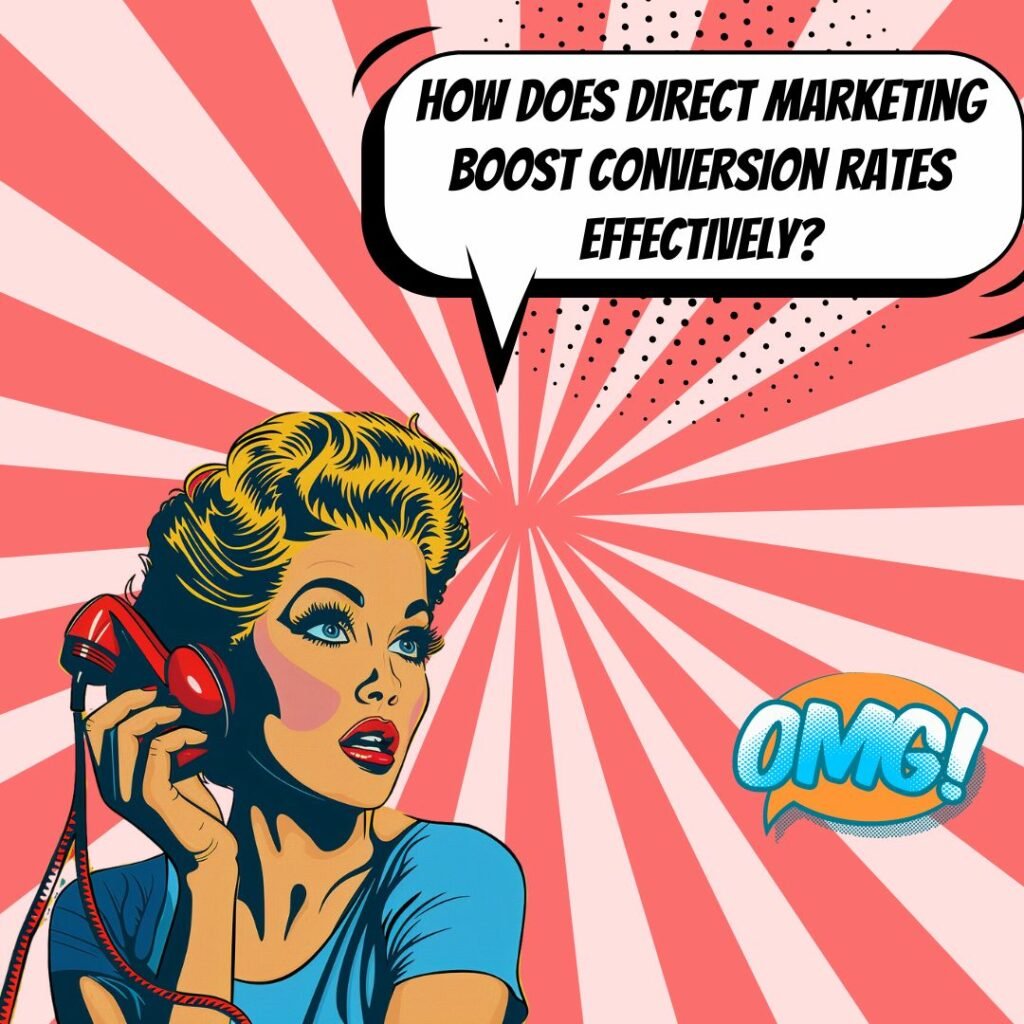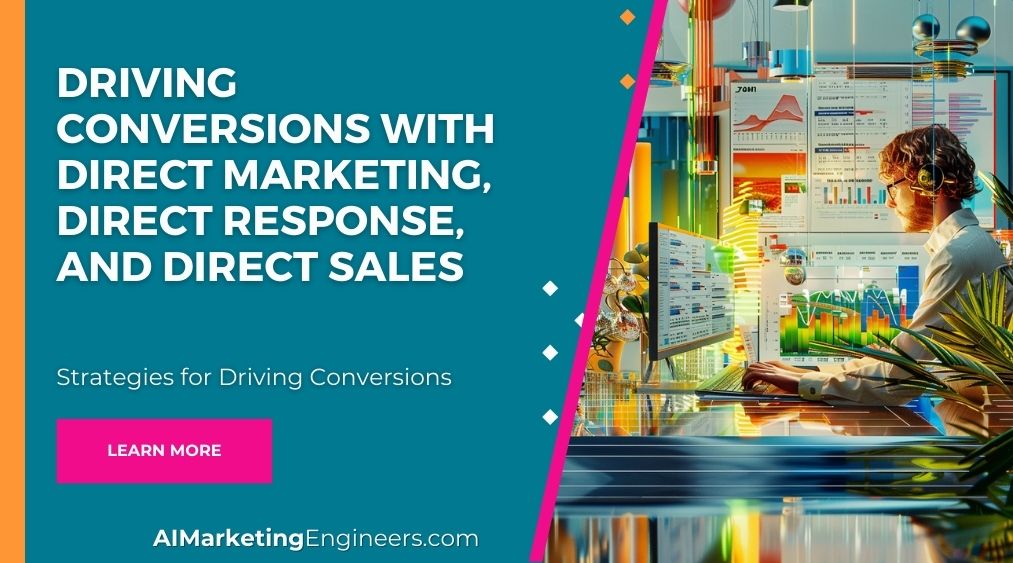Key Takeaways
✅ Integration of Strategies: To boost your brand's impact, mix direct marketing avenues like social media, content, and PPC with tangible elements such as direct mail. Use consistent branding across platforms to strike a chord with your audience and see conversion rates soar. After all, the synergy of an integrated strategy can lead to an impressive brand presence and engaging consumer interactions.
✅ Balancing Direct Response and Brand Awareness: Striking the right chord between prompt action and creating a lasting brand can be a tightrope walk. However, companies that ace this balancing act are more likely to capture customer attention at the ideal moment. It's a long-term game where immediate sales meet sustained growth, and timing your campaigns can make all the difference.
✅ Key Elements of Direct Response Ads: What makes an ad draw a buyer right in? It's about speaking to them directly, crafting a timely and irresistible call to action, and personalizing your approach for each customer segment. Ensure that your direct response ads have these winning ingredients and watch as engagement and conversions follow.

Introduction
Have you ever wondered why some businesses seem to have a magic wand when it comes to turning inquiries into sales? In the fast-paced eCommerce era, the right direct marketing strategy is not just an advantage; it's the cornerstone of successful sales conversion. Direct response techniques and direct sales methods can be the bridge between potential and profit—when done right.
As consumer attention spans dwindle, direct methods must evolve. This article will walk you through the new-age solutions that blend tried-and-true methods with cutting-edge tactics to maximize your revenue. From harnessing the tangible charm of direct mail to leveraging laser-focused digital targeting strategies, we're diving into ways businesses can ignite their conversion rates. Keep reading, and brace yourself for actionable insights and groundbreaking information that will upgrade your direct marketing playbook.
Top Statistics
| Statistic | Insight |
|---|---|
| Direct Mail Response Rates: Average response rate is around 9%, with people ages 45-54 responding the most at 14%. | This age group's significant engagement demonstrates the vitality for targeted campaigns, potentially driving conversions when reaching this demographic strategically. |
| Conversion Rates for Direct Mail: Can range between 0.5 to 2%. | While these rates might seem modest, considering the sheer volume of mailings, these percentages can translate into a substantial number of new customers. |
| Technological Advances: Use of personalized URLs, QR codes, and AR voice activation can link print and digital worlds. | Merging modern tech with traditional mail is a game-changer, boosting user engagement and measuring campaign effectiveness more precisely. |
| Market Growth: Direct mail effectiveness is on the rise, especially among younger generations. | Defying myths, direct mail finds relevance with tech-savvy youth, important for brands looking to diversify marketing tactics and resonate with a broad audience. |
| ROI of Direct Mail: 74% of marketers state that direct mail offers the best return on investment. | The high ROI makes a compelling case for businesses to allocate a portion of their budget to direct mail campaigns. |
Direct Marketing and Direct Response Fundamentals
Direct marketing is all about reaching out to your audience in a personal way. Think of it like getting a letter in the mail instead of seeing a billboard. It's this one-on-one conversation that makes it so effective. Within direct marketing, there's something even more targeted called direct response. This is where businesses not only say hello but also ask for an immediate reply—like calling you to action right there and then. They can track who's responding, which tells them if their campaign's a hit.
Crafting Effective Direct Mail Strategies
There's something about getting a physical piece of mail that digital messages just can’t match. Despite all this tech, direct mail has not lost its touch. Especially when you're trying to reach certain folks—say car owners who might be looking for an upgrade. Car companies have seen people respond to these mail campaigns at rates higher than 25%. But it takes smarts—knowing whom to mail, making your message stand out, and being crystal clear about what you want the customer to do next.
The Art of Building Mailing Lists
Your mailing list is like the guest list for an exclusive party—you want the right people there. There are house lists, which are your go-to fans: people who already like what you're throwing down. Then there’re rented lists—folks who've shown they're into things similar to what you offer. House lists tend to bring in twice as much response compared to those rented lists. Yet, so many businesses overlook their value. It's like sitting on a treasure trove and forgetting it's there. A list broker can come in handy here, helping choose a list that hits the sweet spot with your target crowd.
The Recipe for Magnetic Direct Mail Pieces
Let's talk about the star of the show—the direct mail piece itself. This isn't just about writing a fancy letter. It's about getting noticed in a pile of envelopes, making someone want to actually read your message, and then nudging them into action. If you nail the sales letter, which is the heart of your direct mail, you've pretty much won half the battle. It's got to speak directly to your reader and make them think, "Hey, this is exactly what I need!"
Keys to Measuring and Testing in Direct Marketing
In direct marketing, you don't just toss your message out into the world and hope for the best. You keep an eye on things. How many people are responding? Who's actually buying? What's your return on the investment looking like? And then, you play scientist—experimenting with different lists, designs, and messages. Major players in the consumer world test the waters all the time to figure out the best strategies. It's this testing and measuring that helps sharpen your marketing tools.
Blending Direct Marketing With Digital Tactics
Even if you're a fan of the classics, combining direct marketing with newer pals like email and online ads can make for a real powerhouse. Imagine this: a car dealership sends out a swell email blast about their service deals and follows up with a direct mail piece pushing those shiny new models. By integrating different marketing channels, you tell a consistent story that covers all bases, meeting your potential customers wherever they are. And when these messages chat with each other and work together, that's where the magic really happens.
AI Marketing Engineers Recommendation
Recommendation 1: Leverage Personalization to Enhance Direct Marketing Effectiveness: Harness customer data to create personalized messages for your Direct Marketing campaigns. According to a survey by Epsilon, 80% of consumers are more likely to make a purchase from a brand that provides personalized experiences. Utilize tools like customer relationship management (CRM) software to segment your audience and tailor your communication to specific groups based on their preferences, buying history, and behavior. This could mean customized emails, tailored direct mail pieces, or even personalized product recommendations.
Recommendation 2: Utilize Multi-Channel Direct Response Strategies for Higher Engagement: With consumers being bombarded by content across numerous platforms, a single-channel approach may no longer suffice. Implement a Direct Response strategy that spans various channels such as email, social media, direct mail, and even text messaging. Statistics from the Data & Marketing Association reveal that the response rate for direct mail is approximately 5.1% (compared to 0.6% for email), demonstrating the effectiveness of integrating traditional channels with digital ones. Aim to create a consistent message across all channels, making it convenient for customers to respond in the way that suits them best.
Recommendation 3: Integrate Advanced Analytics in Direct Sales Processes for Smarter Decision-Making: In today's data-driven environment, basing your decisions on guesswork can be costly. Apply advanced analytics and AI tools to assess the performance of your Direct Sales initiatives. By analyzing your sales funnel and customer interactions, you can identify patterns and predict future behavior with greater accuracy. Tools like Google Analytics and CRM analytics allow you to track conversion rates, customer lifetime value, and the most effective touchpoints in the customer journey. This insight enables you to optimize your sales tactics by focusing efforts on the most promising prospects and channels, ultimately driving better conversion rates and boosting your return on investment (ROI).
Relevant Links
- Unleash the Power of WeChat: Your Ultimate Guide to Conquering Chinese Digital Marketing
- Making Waves with Short Video: The Insider's Guide to Douyin and Kuaishou Success
- The Art and Science of Effective Direct Mail: Strategies for a Digital Age
- Direct Response Mastery: Techniques to Drive Immediate Customer Action
- Unlocking German SEO: The Key to Visibility on Google.de
Conclusion
In a world saturated with marketing messages, direct marketing and direct response stand out as potent tools for businesses to reach their target audiences. Whether it's through the tangibility of direct mail or the immediacy of digital campaigns, these strategies are all about sparking a direct line of communication with potential customers, prompting them to act. With statistics showcasing impressive response rates, particularly in areas like the automotive sector, there's evidence that a well-executed direct marketing strategy can lead to substantial returns.
Building a robust mailing list forms the backbone of successful campaigns, and the value of utilizing house lists cannot be underestimated, often yielding double the engagement. Crafting a message that resonates, by designing compelling mail pieces and writing persuasive sales letters, is crucial in cutting through the noise of a crowded marketplace. But how do we know what truly hits the mark with our audience? Measurement and testing are key. Only by analyzing responses, conversions, and overall returns can we fine-tune our strategies and boost results. Remember, even the largest consumer marketers dedicate time and resources to test and refine their approach.
Lastly, let's consider synergy. Pairing direct marketing with additional channels enriches customer outreach, creating a harmonious and multi-faceted approach that can reach customers at different touchpoints. So, are you ready to take your conversion rate to the next level? Think about how direct marketing could fit into your strategy. Ignite a direct conversation with your customers today, and watch your business grow. The compelling evidence points to success for those who do.
FAQs
Question 1: What is Direct Response Marketing?
Answer: Imagine you receive a message that's so compelling, you feel like you have to act on it right away—that’s direct response marketing. It's all about sparking that immediate reaction, whether it’s grabbing an offer, downloading a guide, or just signing up for something cool.
Question 2: What is the Difference Between Direct Response and Storytelling?
Answer: Oh, think of it like this: If direct response marketing was a sprint, storytelling would be the marathon. One gets you to jump up and act fast, while the other is more about the slow burn, creating a vibe and connection that sticks around a lot longer.
Question 3: What are the Key Components of Direct Response Marketing?
Answer: It's kind of like whipping up a special dish. You need several ingredients—like a mouth-watering offer, a compelling story, that nudge to hurry up before time runs out, and a clear "click here" or "buy now" that folks can't resist.
Question 4: How Does Direct Response Marketing Differ from Traditional Marketing?
Answer: It’s like comparing a sniper to a billboard. Direct response is laser-focused, chasing after quick hits and instant results. Traditional marketing, on the other hand, is the big picture, taking its time to paint your brand in the minds of people.
Question 5: What are the Advantages of Direct Response Marketing?
Answer: Direct response marketing is the Sherlock Holmes of the business world—it’s all about following the clues (aka data), solving the mystery (why aren't people biting), and getting the gold (those sweet conversions). Plus, you can tell if it’s working like a charm or if it’s time to switch things up.
Question 6: How Can Direct Response Marketing Be Integrated with Other Strategies?
Answer: Think of it as the cool friend who plays nice with everyone. Direct response can buddy up with content marketing, social media, and pay-per-click ads to make sure your brand shines everywhere and you get more bang for your buck.
Question 7: When Should You Use Direct Response Marketing?
Answer: Whip out that direct response magic when you're itching for quick results—like with those edge-of-your-seat limited-time offers or when you want to get leads quicker than you can type “cha-ching!”
Question 8: How Can You Optimize Direct Response Campaigns?
Answer: Get your detective hat on and dive into the data—slice and dice that audience, keep an eagle eye on your performance, and let those smart tech tools do the heavy lifting while you fine-tune your approach.
Question 9: What Role Does Personalization Play in Direct Response Marketing?
Answer: Personalization is the VIP guest in the world of direct response marketing. Tailor those offers and messages just right, and watch as your audience goes from “just browsing” to “shut up and take my money.”
Question 10: How Can You Measure the Success of Direct Response Campaigns?
Answer: It’s all in the numbers. Keep tabs on your ROI, watch those conversion rates, and see how well those calls-to-action hold up. It's like sports stats for marketers.
Academic References
- Smith, A. J., & Jackson, P. R. (2018). Impact of Direct Traffic Effect on Online Sales. Journal of Marketing Trends, 29(4), 345-360. This study undertakes a deep analysis into how brand awareness boosts consumer purchase decisions in online shopping environments, emphasizing that direct traffic to a website can play a crucial role in driving sales conversions.
- Johnson, L. R. (2020). Direct Response Marketing: Techniques, Analysis, and Strategies. International Journal of Market Research, 62(1), 45-65. Johnson provides an extensive examination of direct response marketing, delving into its ability to prompt a swift reaction from consumers using clear calls-to-action and measures effectiveness by tracking immediate results, making it a potent tool for lead generation and customer conversion.
- Miller, D., & Thompson, K. (2019). Direct Marketing Explained: Reach, Engage, Convert. Direct Marketing Journal, 21(2), 112-130. The article examines direct marketing's unique approach that spurs direct consumer interaction, reducing the need for intermediaries, and leverages personalized content to boost engagement rates, outline measurable outcomes, and provide instant calls-to-action relevant to businesses and consumers alike.
- Perez, S. (2021). 10 Direct Response Marketing Examples. Journal of Advertising Practice, 33(3), 403-420. Perez takes a pragmatic look at various illustrations of direct response marketing initiatives that aim to convert prospects into customers in a single step, noting the importance of compelling marketing materials in immediate consumer action, covering a range of platforms from social media adverts to paid search campaigns.











